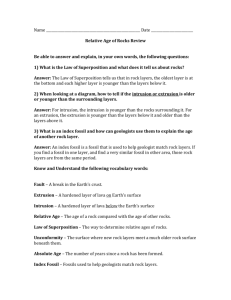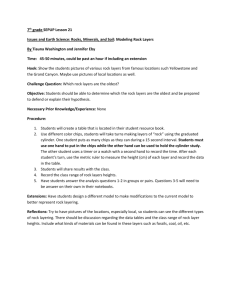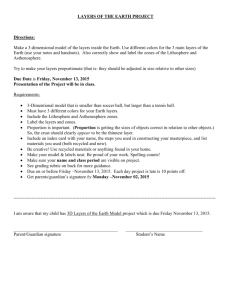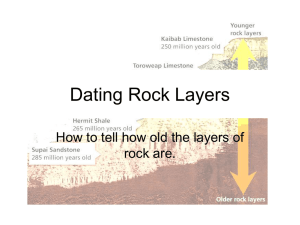Script
advertisement
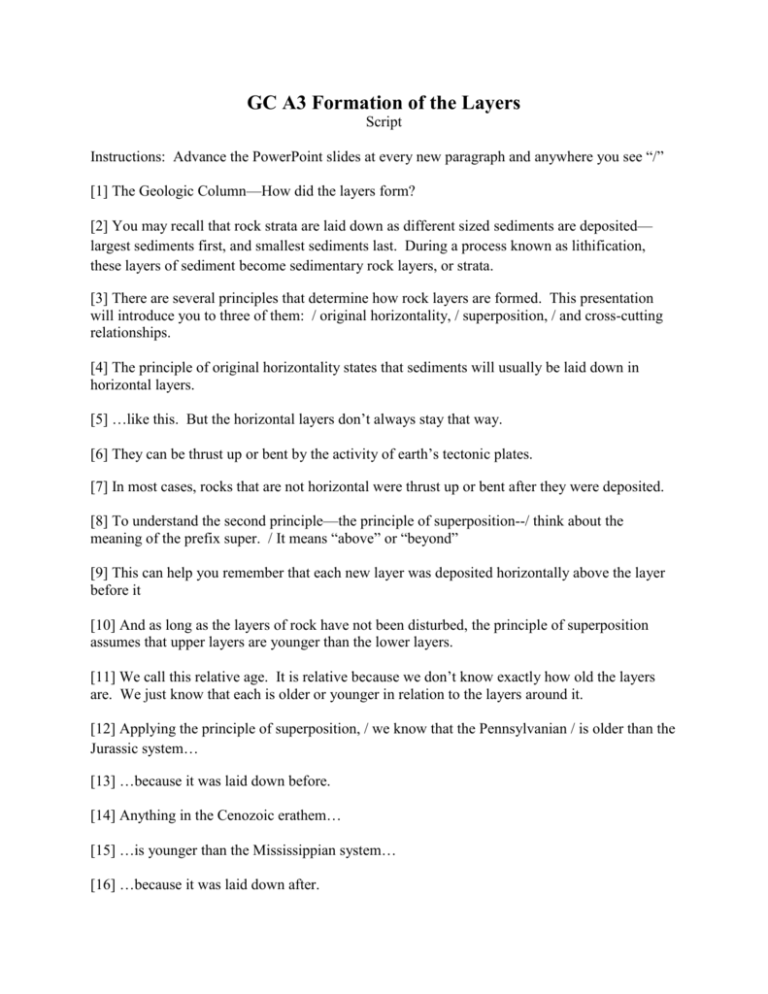
GC A3 Formation of the Layers Script Instructions: Advance the PowerPoint slides at every new paragraph and anywhere you see “/” [1] The Geologic Column—How did the layers form? [2] You may recall that rock strata are laid down as different sized sediments are deposited— largest sediments first, and smallest sediments last. During a process known as lithification, these layers of sediment become sedimentary rock layers, or strata. [3] There are several principles that determine how rock layers are formed. This presentation will introduce you to three of them: / original horizontality, / superposition, / and cross-cutting relationships. [4] The principle of original horizontality states that sediments will usually be laid down in horizontal layers. [5] …like this. But the horizontal layers don’t always stay that way. [6] They can be thrust up or bent by the activity of earth’s tectonic plates. [7] In most cases, rocks that are not horizontal were thrust up or bent after they were deposited. [8] To understand the second principle—the principle of superposition--/ think about the meaning of the prefix super. / It means “above” or “beyond” [9] This can help you remember that each new layer was deposited horizontally above the layer before it [10] And as long as the layers of rock have not been disturbed, the principle of superposition assumes that upper layers are younger than the lower layers. [11] We call this relative age. It is relative because we don’t know exactly how old the layers are. We just know that each is older or younger in relation to the layers around it. [12] Applying the principle of superposition, / we know that the Pennsylvanian / is older than the Jurassic system… [13] …because it was laid down before. [14] Anything in the Cenozoic erathem… [15] …is younger than the Mississippian system… [16] …because it was laid down after. [17] This idea of relative age is reflected in these names. [18] Notice that these names have the same suffix but have different prefixes. [19] The suffix “zoic” is a little like the word zoo and means animal life. But in this case, it doesn’t refer to living animals. It refers to the fossilized remains of animals that used to be alive. [20] The prefixes are what make the words reflect the idea of relative age. [21] Paleo means old. [22] Meso means middle. [23] And Ceno means recent. [24] So Paleozoic means old animal life… [25] Mesozoic means middle animal life… [26] and Cenozoic means recent animal life [27] In other words, these names reflect the idea that the fossilized creatures found in the Paleozoic / are older than those fossilized in the Mesozoic, which are older than those preserved in the Cenozoic. [28] So far we have learned the principles of original horizontality / and superposition. / Next we will learn about the third principle / cross-cutting relationships. [29] Sometimes rock layers are cut by other features, like earthquake faults or intrusions of magma. [30] The Principle of cross-cutting relationships states that—because the rock layers were there first—/ they are older than any features that were produced by later events. [31] Take an earthquake fault for example. [32] Because the layers were there before the earthquake, they are considered to be “older.” / The fault is described as “younger” or more recent. [33] Besides earthquake faults that cut through rock layers, / magma from deep inside the earth can push up through cracks in the rocks. [34] The magma that pushes through the cracks in the pre-existing rock layers to become rock itself / is called an intrusion. [35] The original rock layers are older, / while the intrusion is younger or more recent. [36] To understand the next piece of information about cross-cutting relationships, you will need to pay attention to two very similar words: / intrusion (with a “t”) / and inclusion (with a “c”). [37] Sometimes when magma pushes up between existing rock layers, forming an intrusion, (with a t) [38] Pieces of those rock layers break off and get stuck in the magma. [39] Geologists call these inclusions (with a c). [40] You can remember that by thinking that these pieces of the original rocks are included in the intrusion. [41] Like the original rock layers they came from, / inclusions are older than the younger or more recent intrusion of magma. [42] Let’s review the three principles of relative age that we’ve learned. / Layers are deposited horizontally. / Younger layers are on top of older ones. / Faults and intrusions are younger than the layers they go through. [43] Using these and other principles, scientists try to figure out the exact sequence of events that created the interesting rock layers we find all around the world. [44] In our next presentation, we will learn how to use these principles to tell the relative age of different features in the geologic column.


